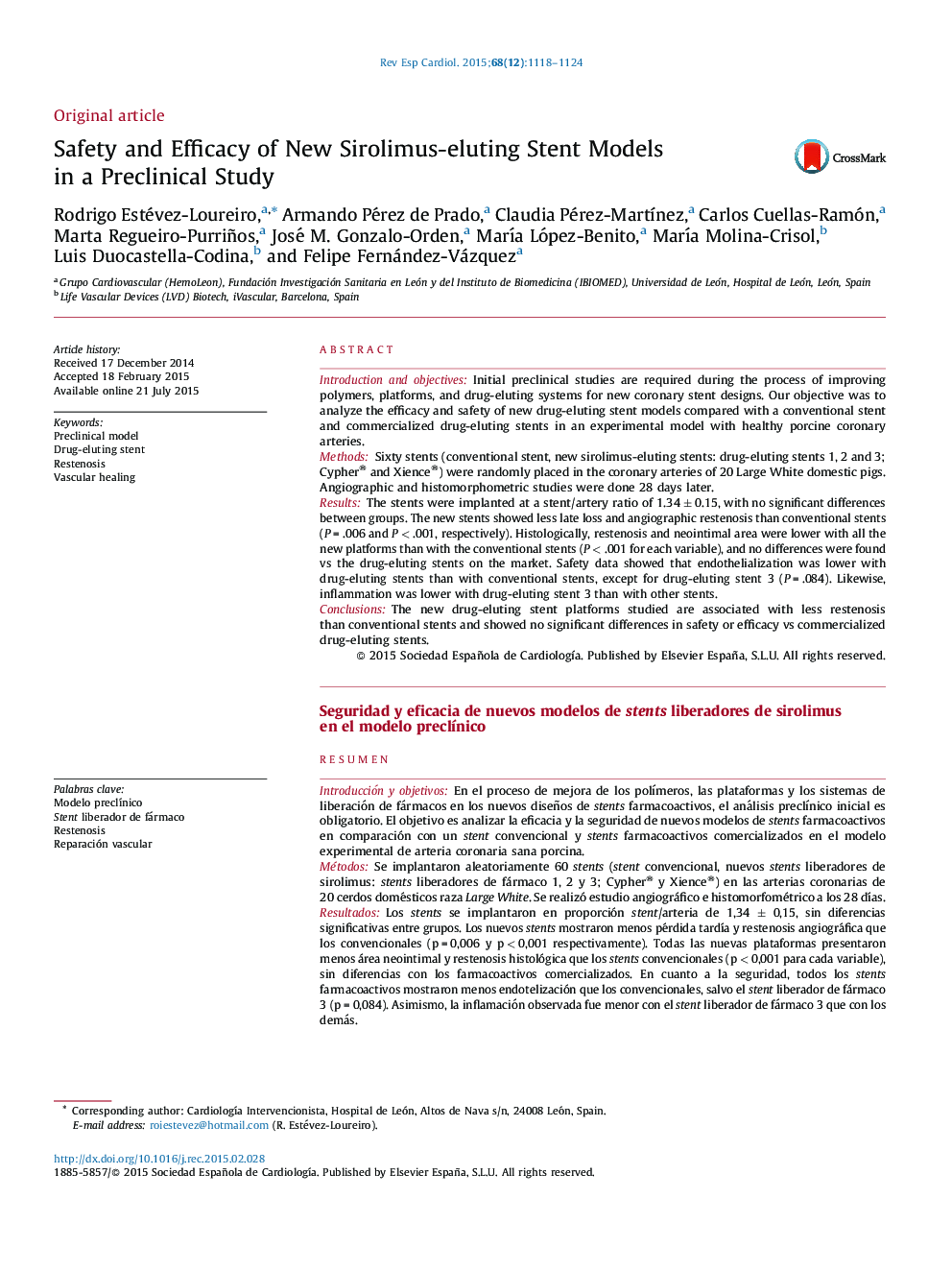| کد مقاله | کد نشریه | سال انتشار | مقاله انگلیسی | نسخه تمام متن |
|---|---|---|---|---|
| 3016187 | 1182074 | 2015 | 7 صفحه PDF | دانلود رایگان |
Introduction and objectivesInitial preclinical studies are required during the process of improving polymers, platforms, and drug-eluting systems for new coronary stent designs. Our objective was to analyze the efficacy and safety of new drug-eluting stent models compared with a conventional stent and commercialized drug-eluting stents in an experimental model with healthy porcine coronary arteries.MethodsSixty stents (conventional stent, new sirolimus-eluting stents: drug-eluting stents 1, 2 and 3; Cypher® and Xience®) were randomly placed in the coronary arteries of 20 Large White domestic pigs. Angiographic and histomorphometric studies were done 28 days later.ResultsThe stents were implanted at a stent/artery ratio of 1.34 ± 0.15, with no significant differences between groups. The new stents showed less late loss and angiographic restenosis than conventional stents (P = .006 and P < .001, respectively). Histologically, restenosis and neointimal area were lower with all the new platforms than with the conventional stents (P < .001 for each variable), and no differences were found vs the drug-eluting stents on the market. Safety data showed that endothelialization was lower with drug-eluting stents than with conventional stents, except for drug-eluting stent 3 (P = .084). Likewise, inflammation was lower with drug-eluting stent 3 than with other stents.ConclusionsThe new drug-eluting stent platforms studied are associated with less restenosis than conventional stents and showed no significant differences in safety or efficacy vs commercialized drug-eluting stents.
ResumenIntroducción y objetivosEn el proceso de mejora de los polímeros, las plataformas y los sistemas de liberación de fármacos en los nuevos diseños de stents farmacoactivos, el análisis preclínico inicial es obligatorio. El objetivo es analizar la eficacia y la seguridad de nuevos modelos de stents farmacoactivos en comparación con un stent convencional y stents farmacoactivos comercializados en el modelo experimental de arteria coronaria sana porcina.MétodosSe implantaron aleatoriamente 60 stents (stent convencional, nuevos stents liberadores de sirolimus: stents liberadores de fármaco 1, 2 y 3; Cypher® y Xience®) en las arterias coronarias de 20 cerdos domésticos raza Large White. Se realizó estudio angiográfico e histomorfométrico a los 28 días.ResultadosLos stents se implantaron en proporción stent/arteria de 1,34 ± 0,15, sin diferencias significativas entre grupos. Los nuevos stents mostraron menos pérdida tardía y restenosis angiográfica que los convencionales (p = 0,006 y p < 0,001 respectivamente). Todas las nuevas plataformas presentaron menos área neointimal y restenosis histológica que los stents convencionales (p < 0,001 para cada variable), sin diferencias con los farmacoactivos comercializados. En cuanto a la seguridad, todos los stents farmacoactivos mostraron menos endotelización que los convencionales, salvo el stent liberador de fármaco 3 (p = 0,084). Asimismo, la inflamación observada fue menor con el stent liberador de fármaco 3 que con los demás.ConclusionesLas nuevas plataformas de stents farmacoactivos estudiadas se asocian con menos restenosis que los convencionales, sin diferencias significativas en seguridad y eficacia respecto a los stents farmacoactivos comercializados.
Journal: Revista Española de Cardiología (English Edition) - Volume 68, Issue 12, December 2015, Pages 1118–1124
